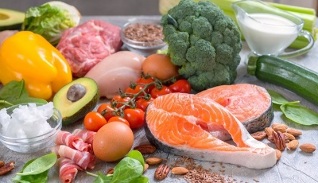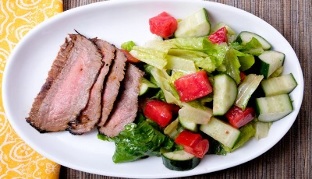
Lack of hunger attacks, clear thinking, and quick release of excess pounds are all benefits of a ketogenic diet. Find out what types of keto diets there are and choose the right one!
The ketogenic diet is no longer new to the world of nutrition and weight loss, but it is still the most controversial method. And all because its followers are convinced that roasted chicken legs and juicy slices can not only lose weight, but never gain weight. Doctors warn: the keto diet is difficult, dangerous, not fully understood, and has many side effects.
The fat diet came to us from the world of medicine, where it was used for a very long time to relieve epileptic seizures in children. It is a type of low carb diet program. However, the main difference between the ketogenic system and the usual one is that fats are the main nutrients in the diet.
How it works
In a normal diet, the best nutrient ratio (BZHU) is 1: 1: 4, meaning carbohydrates are the basis of the diet. These are the main source of energy (calories) and are needed by the nervous system as a source of glucose. However, several studies confirm that this is not entirely true. Swedish scientists have shown that as a result of the growth of fat and protein and the rejection of saccharides after depletion of their own glycogen stores, the body has changed to another "mode". Normal metabolism is recovered and glycides are no longer the main sources of energy. The liver produces a special form of acetone, called ketones (ketone bodies), which move with the bloodstream and affect the oxidation of fatty acids. As a result, our bodies enter a state of ketosis and do not derive energy from carbohydrate chains, but from the products of fat processing, first from the depletion of subcutaneous fat and then from the use of fats from food. Experiments by scientists have confirmed that ketones are more physiological for the brain, while sugars, on the contrary, are cheap and fast energy that will cause degenerative brain diseases in the future.
After overwhelming research, professional athletes and bodybuilders became interested in this method. The two foods became more and more popular, and the diet became a lifestyle that promised rapid weight loss, strengthening and increasing muscle mass, lack of constant hunger, and consequently a different life.
However, despite its effectiveness, doctors warn that a ketogenic diet is linked to the calculation of nutritional standards and is therefore prescribed and monitored by a nutritionist. Proper initiation, maintenance, and control of ketosis are important. If you put together a menu system yourself, it means you pose a big risk to your health!
Main views
Professional athletes distinguish three main types of ketogenic diets:
Normal (SKD - standard ketogenic diet)

This is a basic, linear program with medium or high protein intake, high fat and low saccharide intake. It is characterized by a constant supply of ketogenic nutrients without glucide replenishment. SKD is excellent for people with low activity (sedentary lifestyle, irregular exercise).
How to calculate nutrient balance? Take, for example, the usual ketogenic diet of a 75 kg person with an intensity of exercise 2-3 times a week.
- First, calculate your daily caloric intake (KRday). For example, it will be around 2000 kcal / day.
- The number of proteins required (Bsut) is 2 grams / 1 kg weight, i. e. Bsut = 2 * 75 = 150 grams / day.
- The daily amount of carbohydrates (Usut) is 0, 2-0, 4 grams. For a weight of 1 kg, i. e. 15-30 grams / day (30 grams are used for calculations).
- Calculate how many calories in your daily diet come from proteins and glycides. Each of these nutrients contains 4 calories per gram. Therefore, in our calculation this value is (150 + 30) * 4 = 720 kcal.
- As you can see, in our example, a person should get 1280 kcal (2000-720) of fat. And since 1 gram of fat contains 9 kcal, the daily amount of fat (F / day) = 1280/9 = 142 grams.
As a result of calculations, we found that for this situation, the diet should consist of 150 grams of protein, 30 grams of carbohydrates, and 142 grams of fat, evenly distributed between meals.
Cyclic (CKD - cyclic ketogenic diet)
An opportunity for experienced bodybuilders who feel comfortable in their bodies and understand proper nutrition, calories and diet. CKD is suitable for athletes who train daily and report a decrease in training effectiveness in the background of basic and targeted systems. The purpose of this method is to determine the correct period between carbohydrate loading days (refills) and calculate the amount of glycides that will allow you to work at maximum intensity on your body.

Bodybuilders recommend gradually introducing refills, starting with one dose per week, and monitoring their well-being by adjusting the time interval between loads to suit individual needs. Describe how much carbohydrate was consumed from the food each day and consider overall well-being.
The main rule of the loading day is a decrease in the W / day ratio, while B / day remains unchanged (or ascending). U / day depends on individual insulin sensitivity and is 2-3 g / 1 kg low, 4-5 g / 1 kg normally and 6-7 g / 1 kg high.
Calculate the caloric intake of CDC for our example with normal insulin sensitivity.
- B / day = 2 * 75 = 150 grams / day.
- Y / day = 450-525 grams / day.
- Daily caloric content of proteins and sugars on the day of carbohydrate load (150 + 450) * 4 = 2400 kcal.
- Similar to the previous calculation, we calculate the remaining calories, divide the resulting number by 9, and get how many grams of fat should be in the diet on carb days.
Thus, the calculations showed that on day 6 of the CKD, the menu will be similar to the CKD, and one day (carbohydrate) the caloric content will be 2500 kcal (150 g protein, 300 g carbohydrate and 78 g fat)
TKD ketogenic diet
Suitable for long-term athletes whose performance drastically decreases after a long time without glycides and who may benefit from low carbohydrate intake. It is characterized by short-term "injection" of saccharides under the so-called "training window" (i. e. , before and after training), which increases endurance but will not suppress the process of ketosis. The goal of a targeted ketogenic diet is to increase performance and endurance in the short term. In the absence of training, SKD indicators are taken.
Calculate Y / day before and after training for our example:

- B / day = 2 * 75 = 150 grams / day.
- The increase in Y / day depends on insulin resistance, +0. 5 g / 1 kg at low sensitivity, +0. 75 g / 1 kg at normal and +1 g / 1 kg at high sensitivity. It is advisable to divide these additional carbohydrates into two equal portions and eat them before and after training.
- As in previous calculations, subtract the daily calories from proteins and carbohydrates from the total calories in your diet. The resulting delta will be the calories attributable to the fat.
Attention!This calculation is not a rule, just an example. The indicators of the main menu are calculated on the basis of individual characteristics, the refinement of targeted and cyclic ketogenic diets is done exclusively by experimental and error correction methods, based on well-being, performance indicators, endurance, intensity and training duration. If you do not trust your abilities and experience, we recommend that you contact a nutritionist.
Rules
Follow these guidelines to achieve the weight loss results you want:
- Start with a day of fasting. Only water is allowed.
- Your diet should include: “right” fats - 60%, protein - 30%, carbohydrates in at least 10% of your daily caloric intake.
- Mandatory intake of vitamins and minerals (calcium, vitamin D, folic acid).
- Drink as much as you can.
- Consume food from the whitelist.
Authorized and Prohibited Products
Facilitates the development and maintenance of ketosis:
- high fat fermented dairy products (including cottage cheese);
- fat, fatty meat, poultry skin;
- sausage (jamon, balyk, cooked pork);
- fish (preferably fatty) and seafood;
- hard cheeses (try to choose cheeses that contain a minimal amount of carbohydrates);
- avocado;
- oils (butter, unrefined vegetable oils, coconut);
- mushroom;
- fiber-rich vegetables;
- banana;
- walnuts, walnut butter;
- pumpkin seeds;
- leaf salads.
Minimum allowed:
- dark, bitter chocolate with maximum cocoa content and minimum sugar;
- raw roots, vegetables, fruits which have not yet undergone heat treatment;
- tea, coffee.
Prohibited Products:
- carbonated beverages;
- sugar, honey;
- bakery products, bread;
- cereals;
- dried fruits;
- skim milk, kefir, yogurts;
- margarine, spreadable;
- pasta;
- Starchy vegetables.
Menu

When preparing a menu for a ketogenic diet for a week, nutrition experts recommend that you don’t focus on the weight of the food, but create a menu based on its amount and BJU ratio.
Approximate ketogenic menu for one week, taking into account the recommendations.
Monday
- Breakfast: scrambled eggs with 2 eggs; hard cheese; bacon; A cup of coffee.
- Lunch: vegetable salad (leafy "Iceberg" + cucumber + celery) with mayonnaise sauce; fried chicken skin; hard cheese.
- Dinner: steak; cauliflower steamed with mushrooms; coffee with cream.
Tuesday
- Breakfast: slice; hard cheese; cup of americano with milk.
- Lunch: salmon steak with cream sauce; steamed broccoli; salad with cheese and eggs, mayonnaise dressing.
- Dinner: pork chop; braised cabbage; green salad; tea.
Wednesday
- Breakfast: 6 egg omelette with grated cheese (protein substitute); soy milk - 0, 5 l.
- Lunch: smoked breast; fried zucchini with cheese.
- Dinner: red fish with cream sauce; vegetable salad with mayonnaise; yogurt.
Thursday
- Breakfast: soft-boiled eggs - 4-5 pieces; any sauce - 2-3 tablespoons. channels; vegetable salad with cheese.
- Lunch: mushrooms steamed in sour cream; spinach salad; Fried fish.
- Dinner: steak; toast with honey; milk.
Friday
- Breakfast: scrambled eggs (3-4 eggs); protein shake; hard cheese.
- Lunch: scrambled eggs; fried chicken breast; hard cheese.
- Dinner: salmon; roasted almonds; salad.
Saturday
- Breakfast: salmon; grapefruit; salad.
- Lunch: fish; vegetable stew; a mixture of nuts.
- Dinner: vegetable salad; a couple of sausages; cheese.
Sunday
- Breakfast: eggs in a bag; cheese; green salad.
- Lunch: turkey; tomato salad with mayonnaise; cheese.
- Dinner: cottage cheese; grapefruit.
Be sure to follow your drinking routine. Drink at least 1, 5 liters of water during the day.
Contraindications and side effects
You may feel weak, lethargic, and depressed for a few days after starting a ketogenic diet. Such a diet is not natural and is therefore particularly dangerous for a growing organism. In adolescents, this food is categorically contraindicated. The following side effects may occur with a long-term or improper ketogenic diet:
- urolithiasis;
- increased bad cholesterol in the blood;
- peristalsis, violation of the functional state of the gastrointestinal tract (gastroesophageal reflux);
- dehydration (because carbohydrates remove excess water);
- inhibited growth (in adolescents) due to protein deficiency;
- vitamin deficiency;
- mineral deficiency and resulting bone remineralization, osteoporosis;
- inflammation of the pancreas (pancreatitis);
- hormonal imbalance and menstrual cycle failure;
- ketoacidosis.
Therefore, in order to avoid the development of pathological diseases and the aggravation of existing ones, the diet is checked by a specialist. At weight loss, the condition should be checked monthly, and basic tests (blood, urine) should be given. The ketogenic diet will be corrected or waived by your doctor based on the results of the test.




























